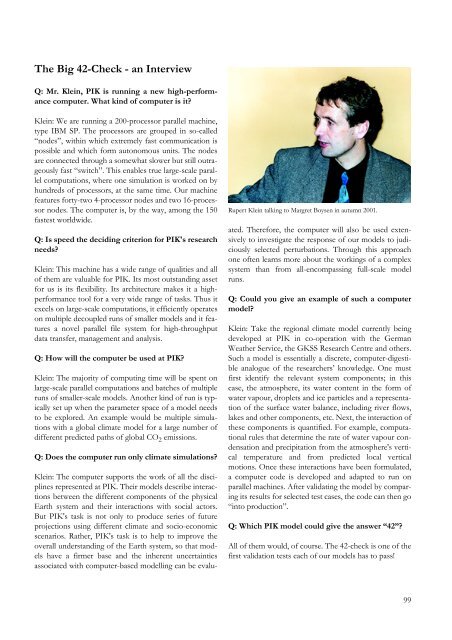PIK Biennial Report 2000-2001 - Potsdam Institute for Climate ...
PIK Biennial Report 2000-2001 - Potsdam Institute for Climate ...
PIK Biennial Report 2000-2001 - Potsdam Institute for Climate ...
You also want an ePaper? Increase the reach of your titles
YUMPU automatically turns print PDFs into web optimized ePapers that Google loves.
The Big 42-Check - an Interview<br />
Q: Mr. Klein, <strong>PIK</strong> is running a new high-per<strong>for</strong>mance<br />
computer. What kind of computer is it?<br />
Klein: We are running a 200-processor parallel machine,<br />
type IBM SP. The processors are grouped in so-called<br />
“nodes”, within which extremely fast communication is<br />
possible and which <strong>for</strong>m autonomous units. The nodes<br />
are connected through a somewhat slower but still outrageously<br />
fast “switch”. This enables true large-scale parallel<br />
computations, where one simulation is worked on by<br />
hundreds of processors, at the same time. Our machine<br />
features <strong>for</strong>ty-two 4-processor nodes and two 16-processor<br />
nodes. The computer is, by the way, among the 150<br />
fastest worldwide.<br />
Q: Is speed the deciding criterion <strong>for</strong> <strong>PIK</strong>'s research<br />
needs?<br />
Klein: This machine has a wide range of qualities and all<br />
of them are valuable <strong>for</strong> <strong>PIK</strong>. Its most outstanding asset<br />
<strong>for</strong> us is its flexibility. Its architecture makes it a highper<strong>for</strong>mance<br />
tool <strong>for</strong> a very wide range of tasks. Thus it<br />
excels on large-scale computations, it efficiently operates<br />
on multiple decoupled runs of smaller models and it features<br />
a novel parallel file system <strong>for</strong> high-throughput<br />
data transfer, management and analysis.<br />
Q: How will the computer be used at <strong>PIK</strong>?<br />
Klein: The majority of computing time will be spent on<br />
large-scale parallel computations and batches of multiple<br />
runs of smaller-scale models. Another kind of run is typically<br />
set up when the parameter space of a model needs<br />
to be explored. An example would be multiple simulations<br />
with a global climate model <strong>for</strong> a large number of<br />
different predicted paths of global CO 2 emissions.<br />
Q: Does the computer run only climate simulations?<br />
Klein: The computer supports the work of all the disciplines<br />
represented at <strong>PIK</strong>. Their models describe interactions<br />
between the different components of the physical<br />
Earth system and their interactions with social actors.<br />
But <strong>PIK</strong>'s task is not only to produce series of future<br />
projections using different climate and socio-economic<br />
scenarios. Rather, <strong>PIK</strong>'s task is to help to improve the<br />
overall understanding of the Earth system, so that models<br />
have a firmer base and the inherent uncertainties<br />
associated with computer-based modelling can be evalu-<br />
Rupert Klein talking to Margret Boysen in autumn <strong>2001</strong>.<br />
ated. There<strong>for</strong>e, the computer will also be used extensively<br />
to investigate the response of our models to judiciously<br />
selected perturbations. Through this approach<br />
one often learns more about the workings of a complex<br />
system than from all-encompassing full-scale model<br />
runs.<br />
Q: Could you give an example of such a computer<br />
model?<br />
Klein: Take the regional climate model currently being<br />
developed at <strong>PIK</strong> in co-operation with the German<br />
Weather Service, the GKSS Research Centre and others.<br />
Such a model is essentially a discrete, computer-digestible<br />
analogue of the researchers’ knowledge. One must<br />
first identify the relevant system components; in this<br />
case, the atmosphere, its water content in the <strong>for</strong>m of<br />
water vapour, droplets and ice particles and a representation<br />
of the surface water balance, including river flows,<br />
lakes and other components, etc. Next, the interaction of<br />
these components is quantified. For example, computational<br />
rules that determine the rate of water vapour condensation<br />
and precipitation from the atmosphere's vertical<br />
temperature and from predicted local vertical<br />
motions. Once these interactions have been <strong>for</strong>mulated,<br />
a computer code is developed and adapted to run on<br />
parallel machines. After validating the model by comparing<br />
its results <strong>for</strong> selected test cases, the code can then go<br />
“into production”.<br />
Q: Which <strong>PIK</strong> model could give the answer “42”?<br />
All of them would, of course. The 42-check is one of the<br />
first validation tests each of our models has to pass!<br />
99

















